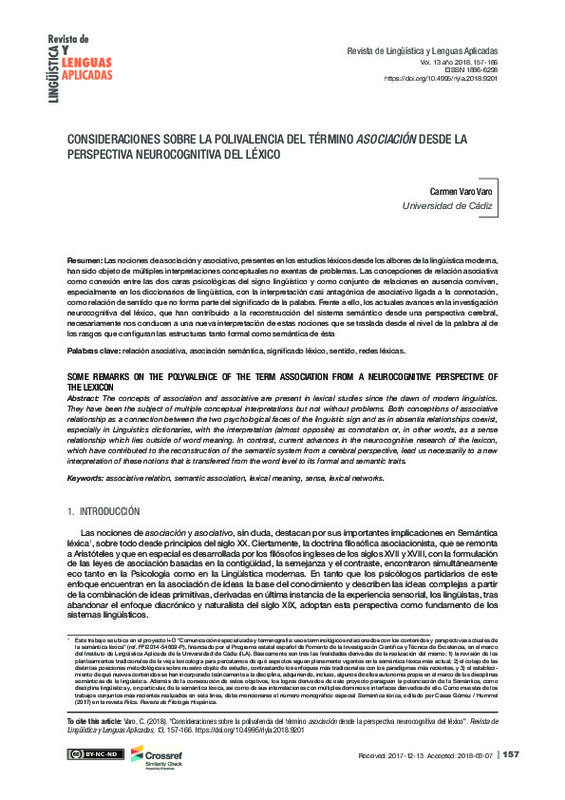Bally, C. (1940). "L'arbitraire du signe. Valeur et signification". Le Français Moderne, 8/3, 93-206.
Casas Gómez, M. (2002). Los niveles del significar. Documentos de Investigación Lingüística, 7. Cádiz: Universidad de Cádiz.
Casas Gómez, M., Hummel, M. (2017). Semántica léxica. Volumen monográfico de Rilce. Revista de Filología Hispánica, 33/3. Pamplona: Universidad de Navarra.
[+]
Bally, C. (1940). "L'arbitraire du signe. Valeur et signification". Le Français Moderne, 8/3, 93-206.
Casas Gómez, M. (2002). Los niveles del significar. Documentos de Investigación Lingüística, 7. Cádiz: Universidad de Cádiz.
Casas Gómez, M., Hummel, M. (2017). Semántica léxica. Volumen monográfico de Rilce. Revista de Filología Hispánica, 33/3. Pamplona: Universidad de Navarra.
Coseriu, E. (1977). Principios de semántica estructural. Madrid: Gredos.
Cree, G. S., McRae, K., McNorgan, C. (1999). "An attractor model of lexical conceptual processing: simulating semantic priming". Cognitive Science, 23/3, 371-414. https://doi.org/10.1207/s15516709cog2303_4
Fischler, I., Goodman, G. O. (1978). "Latency of associative facilitation in memory". Journal of Experimental Psychology: Human Perception and Performance, 4, 455-470. https://doi.org/10.1037/0096-1523.4.3.455
Garagnani, M., Pulvermüller, F. (2016). "Conceptual grounding of language in action and perception: a neurocomputational model of the emergence of category specificity and semantic hubs". European Journal of Neuroscience, 43/6: 721-737. https://doi.org/10.1111/ejn.13145
Geckeler, H. (1976). Semántica estructural y teoría del campo léxico. Madrid, Gredos.
Geckeler, H. (1981). "Structural Semantics", Eikmeyer, H.-J./ Rieser, H. (eds.). Words, worlds, and contexts. New approaches in word semantics. Berlin/New York: Walter de Gruyter, 381-414. https://doi.org/10.1515/9783110842524-017
Hebb, D. (1949). The Organization of Behavior: a Neuropsychological Theory. New York: John Wiley & Sons.
Kiefer, M., Pulvermüller, F. (2012). "Conceptual representations in mind and brain: theoretical developments, current evidence and future directions". Cortex, 48, 805-25. https://doi.org/10.1016/j.cortex.2011.04.006
Kruesi, E. E. (1978). The role of association and semantic similarity in facilitating the lexical decision. PhD. Dissertation. University of California.
Lamb, S. (1999). Pathways of the brain. The neurocognitive basis of language. Amsterdam/Philadelphia: John Benjamins. https://doi.org/10.1075/cilt.170
Lamb, S., Webster, J. (ed.) (2004). Language and reality: selected writings of Sydney Lamb. London: Continuum International Publishing.
McClelland, J., Rumelhart, D. (1985). "Distributed memory and the representation of general and specific information". Journal of Experimental Psychology: General, 114, 159-188. https://doi.org/10.1037/0096-3445.114.2.159
Plaut, D. C. (2003). "Connectionist modelling of language: examples and implications". Banich, M.T. and Mack, M. (eds.) Mind, brain, and language. Mahwah, NJ: Lawrence Erlbaum Associates, 143-167.
Postman, L., Keppel, G. (eds.) (1970). Norms of word association. New york: Academic Press.
Pottier, B. (1963). Recherches sur l'analyse sémantique en linguistique et en traduction mécanique. Nancy, Université de Nancy.
Pottier, B. (1976). "Hacia una semántica moderna". Lingüística moderna y filología hispánica. Madrid: Gredos, 99-133.
Pulvermüller, F. (2001). "Brain reflections of words and their meanings". Trends in Cognitive Sciences, 5/12, 217-24. https://doi.org/10.1016/S1364-6613(00)01803-9
Pulvermüller, F. (2005). The neuroscience of language. Reimpr. Cambridge: Cambridge University Press.
Pulvermüller, F. (2012). "Meaning and the brain: the neurosemantics of referential, interactive, and combinatorial knowledge". Journal of Neurolinguistics, 25, 423-59. https://doi.org/10.1016/j.jneuroling.2011.03.004
Pulvermüller, F. (2013). "How neurons make meaning: brain mechanisms for embodied and abstract-symbolic semantics". Trends in Cognitive Sciences, 17/9, 458-70. https://doi.org/10.1016/j.tics.2013.06.004
Radwańska-Williams, J. (1994). A paradigm Lost. The linguistic thought of Mikołaj Kruszewski, Studies in the history of the language sciences. Amsterdam ⁄ Philadelphia: John Benjamins. https://doi.org/10.1075/sihols.72
Saussure, F. de (1916/1922, 2ª ed.). Cours deLinguistique Générale. Publié par Ch. Bally et A. Sechehaye avec la collaboration de A. Riedlinger. Paris: Payot.
Sechehaye, C. A. (1926). Essai sur la structure logique de la phrase. Paris: H. Champion.
Shanks, D. R. (1995). The Psychology os associative learning. Cambridge: Cambridge University Press. https://doi.org/10.1017/CBO9780511623288
Trier, J. (1931). Der deutsche Wortschatz im Sinnbezirk des Verstandes. Die Geschichte eines sprachlichen Feldes, I: Von den Anfängen bis zum Beginn des 13. Jahrhunderts. Heidelberg: Carl Winter.
Trujillo, R. (1970). El campo semántico de la valoración intelectual en espa-ol. La Laguna: Universidad de La Laguna.
Trujillo, R. (1997). "El papel de la realidad en la semántica". Casas Gómez, M. (dir.), Espinosa García, J. (ed.), II Jornadas de Lingüística. Cádiz: Universidad de Cádiz, 31-51.
Varo Varo, C. (2010). "El procesamiento de las relaciones léxicas". Revista Espa-ola de Lingüística, 40/1, 149-171.
Varo Varo, C. (2013). "Aproximación teórico-práctica al procesamiento lingüístico de neologismos léxicos". Revista Signos. Estudios de Lingüística, 46/81, 132-52.
Varo Varo, C. (2017). "Nuevos retos en la investigación del contenido léxico: elementos para una neurosemántica". Rilce. Revista de Filología Hispánica, 33/3, 1032-1059. https://doi.org/10.15581/008.33.3.1032-59
[-]








